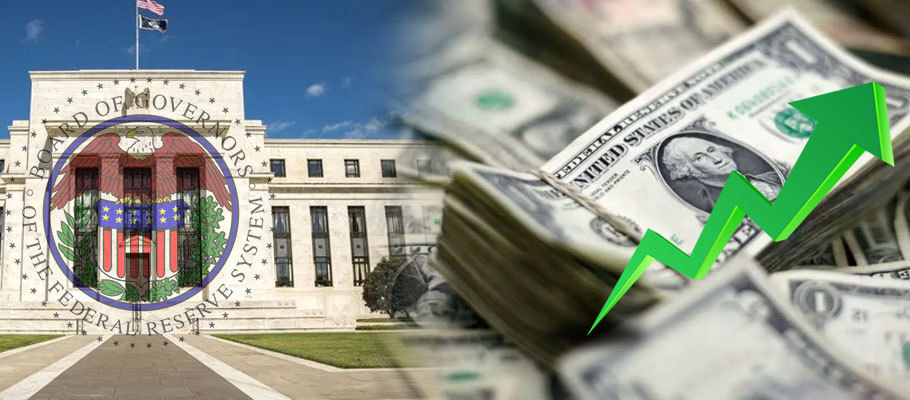
Published: March 23th, 2021
On Friday, March 19, the Federal Reserve let the pandemic-driven reprieve on capital requirements lapse. The action pushed the U.S. Treasury yields from the lowest point of the day. In turn, the dollar surged past major currencies, going past a one-week high.
On Friday, March 19, the dollar inched past the major currencies to record a one-week high. The dollar’s fortunes turned after the Federal Reserve let the pandemic-driven amnesty on capital requirements expire. The Fed’s action altered market sentiment and sent the U.S. yields from their lowest point of the day.
The Fed’s brief announcement said it would allow the alteration to the supplementary leverage ratio (SLR) to expire at the end of the month. The change was first announced on April 1, 2020, to allow banks to keep out capital such as Treasurys and deposits held in Federal banks when computing the leverage ratio.
In recent weeks, the greenback has risen in correlation with the higher Treasury yields. Since the beginning of the year, the gauge that measures the value of the dollar against the six major currencies, the dollar index, has increased by 3.3%. Meanwhile, the benchmark U.S. 10 –year note has climbed by 80 basis points during the same period.
The Federal Reserve announced on Friday, March 19, that it would let the interim regulation directing larger banks to detain more capital against their assets like Treasuries, expire on March 31.
The rule was enacted to encourage banks to make loans available to American households and businesses after they were hurt by the lockdowns.
The dollar index increased by 0.1% for the day to stand at 91.906. On Wednesday, March 17, the same index had declined sharply after the Federal Reserve announced its loose policy stance; sticking to its dovish attitude. Week-on-week, the greenback index rose by 0.6%, posting gains for the three straight weeks in the past four.
According to a research note that ING Group sent to clients, the Treasury’s stance to let the SLR exemption expire has boosted the greenback marginally. The support is mostly via the increase in U.S. Treasury yields, the note added.
The note described the rise in U.S. Treasury yields as “nearly disorderly.” It added that at some point this year, such increases weakened the market’s bias to go for activity currencies experiencing slumps. According to the ING note, the SLR news shifts the narrative by throwing an element of caution into the works.
On Friday, March 19, the benchmark U.S. 10-year yield shot up after the Fed announced its decision about the leverage rule. However, the yield slipped later during the afternoon trading session, to stand at 1.726%. During the previous session, the yield had surpassed its more-than-one-year summit of 1.754%.
Meanwhile, the Federal Reserve pledged in the week that ended on Saturday, March 20, to review its overall approach. Among the agency’s promises is to push ahead with its aggressive monetary stimulus.
According to a statement by the agency, the near-term increase in the rate of inflation would only be temporary. Besides, available data already suggest that the U.S. economic rebound and growth will be the strongest in almost 40 years.
Marc Chandler, the chief market strategist at Bannockburn Global Forex, a Cincinnati-based financial consultancy, said the dollar would be firm, even firmer in the days to come. However, he added that such stability would not take the greenback out of its normal ranges.
Chandler added that the primary macro force determining the currency’s trend is still a combination of many factors. Overall, the analyst added that no one can keep pace with the aggressiveness of the U.S. fiscal and monetary policy.
Meanwhile, the euro slumped slightly by 0.1% to stand at $1.1908. The decline gave early signs of the currency’s position against the greenback regarding fears of continued coronavirus lockdowns in Europe. On Friday, March 19, France imposed a fresh, four-week lockdown in 16 regions it considers badly ravaged by the health crisis.
While other currencies slumped against the dollar, the yen held roughly on a plateau, ending the week at 108.89 for every dollar. The currency’s trend came after the Bank of Japan widened its goal for the benchmark yield. The bank's decision is largely a reflection of the market sentiment.
Overall, the Japanese currency climbed by 0.4% against the greenback week-on-week, its best weekly performance since mid-February.
Cryptocurrencies were also bullish against the dollar. Bitcoin recorded a 2% increase against the dollar, trading at $58,804, after briefly flying past $60,000 the previous day.
Meanwhile, the Fed’s decision to let the pandemic-era rule elapse is likely to unsettle Wall Street and the bond market. The decision was considered a key aspect of soothing what was turning out to be a rocky Treasury market during the early days of the coronavirus pandemic.
A cash crunch had led to an extensive sell-off in the bond market. The Fed helped cover the massive hemorrhage through elaborate liquidity programs. The bank said it would seek public opinion on how to regulate the SLR in the future. However, it would let the rule expire for now as was earlier planned.
The Fed statement reiterated that the bank’s board would apply appropriate actions to make sure that any changes to the regulation do not dilute the overall strength of the capital requirements that banks have to maintain.
Following the announcement, bank stocks slumped taking down the broader market with them. However, government bonds gave mixed reactions. Recently, Wall Street has been lobbying extensively for an extension of the rule.
The Federal Reserve announced on Friday, March 19, that it would let the change on SLR expire at the end of the month as had been planned. The announcement buoyed the dollar as it pushed the 10-year benchmark U.S. Treasury yield on another rally. However, the move is likely to unsettle Wall Street.